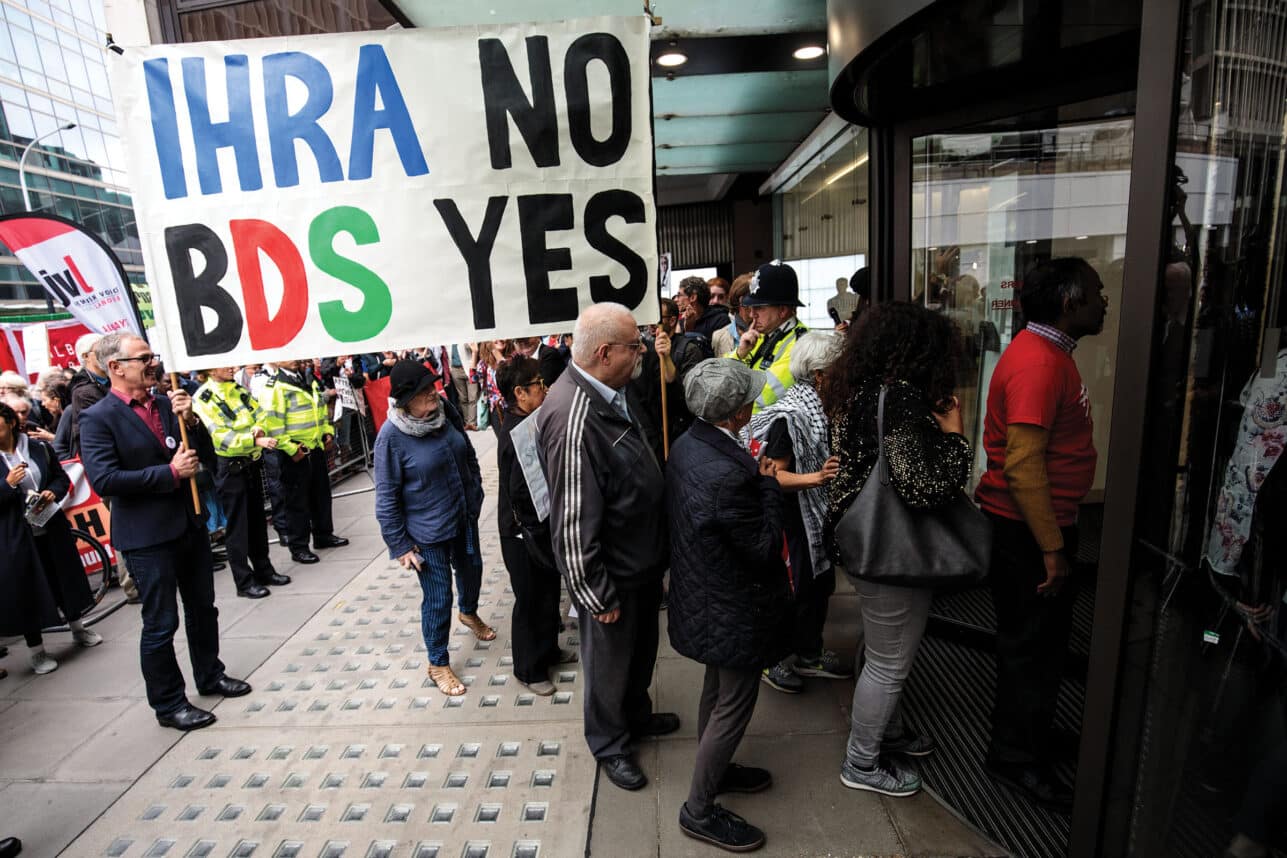 DeAnne Connolly Graham (C) joins with others for an interfaith Rally Against Anti-Semitism, hosted by Greater Miami Jewish Federation at the Holocaust Memorial Miami Beach on June 03, 2021 in Miami Beach, Florida. (Photo by Joe Raedle/Getty Images)
DeAnne Connolly Graham (C) joins with others for an interfaith Rally Against Anti-Semitism, hosted by Greater Miami Jewish Federation at the Holocaust Memorial Miami Beach on June 03, 2021 in Miami Beach, Florida. (Photo by Joe Raedle/Getty Images) In late May, Jewish leaders and organizations across the United States welcomed the Biden administration’s long-awaited National Strategy to Counter Antisemitism. President Biden deserves credit for a strategy that breaks new ground in terms of its level of engagement and its whole-of-government and whole-of-society approach. The authors seem to feel the same way: The strategy reminds readers three times that it represents the most comprehensive and ambitious government effort to counter antisemitism in American history.
Regrettably, the strategy’s commendable goals and novel ideas (and lofty self-appraisal) come hand-in-hand with a hefty list of omissions, distortions and internal contradictions. The adoption of a strategy to counter antisemitism is an important gesture, but the strategy itself is a tendentious mess.
Who Are the Antisemites?
What emerges from the text is that the Biden administration is deeply committed to combating some kinds of antisemitism, but eager to ignore or even downplay others. Herein lies the strategy’s great missed opportunity. The president could have used the unmatched influence of the White House to send an unmistakable message that all types of antisemitism must be fought with equal vigor. Instead, the officials behind the strategy chose to double down on familiar partisan and ideological stances that focus on the antisemitism of rivals while glossing over the antisemitism of colleagues and allies.
The officials behind the strategy chose to double down on familiar partisan and ideological stances that focus on the antisemitism of rivals while glossing over the antisemitism of colleagues and allies.
President Biden himself sets the stage on the first page of his introductory letter to the strategy. After opening with a discussion of the venomous 2017 “Unite the Right” rally in Charlottesville, Virginia, he asserts the organizing principle of the entire document: “People who peddle these antisemitic conspiracy theories and fuel racial, ethnic, and religious hatred against Jews also target other communities — including Black and brown Americans; Asian Americans, Native Hawaiians, and Pacific Islanders; LGBTQI+ individuals; Muslim Americans; women and girls; and so many others.”

In analytic terms, one would say that this is a model with limited explanatory power. The president’s description is accurate when considering the antisemitism of right-wing white supremacists. But what does this understanding say about Islamist antisemitism? Or the antisemitic attacks carried out by Black Hebrew Israelites or other Black Americans? Where does the antisemitism of the extreme left fit in? At best, the strategy ignores these categories of antisemitism. At worst, it goes out of its way to obscure them.
The seizing of a rabbi and congregants as hostages in a Colleyville, Texas synagogue in 2022 provides a telling example. The hostage taker was an Islamist who demanded the release from prison of an al-Qaeda affiliate. The strategy, though, is unwilling to specify any antisemitic ideology other than white supremacy: “antisemitic conspiracy theories are often foundational to white supremacy as well as numerous other violent extremist ideologies. For example, in January 2022, an armed hostage-taker motivated by other violent notions terrorized the members of a synagogue in Colleyville, Texas.”
The strategy mentions Islamophobia more than 20 times, but Islamist antisemitism is nowhere to be found. Those who engage in antisemitic violence and claim to do so in the name of Islam are simply motivated by “other violent notions.” According to the White House, it appears, some antisemitisms must not be named.
The administration has produced a strategy for countering right-wing antisemitism. The endeavor is necessary, but insufficient.
The administration has produced a strategy for countering right-wing antisemitism. The endeavor is necessary, but insufficient.
What Is Antisemitism?
More fundamental than the question of who is guilty of antisemitism is the question of what antisemitism is in the first place. The strategy’s definition of antisemitism was the subject of considerable controversy in the weeks and months before the document was published, with various interested parties lobbying the administration to influence the outcome. The result is that the relevant section of the strategy trips over itself trying to please too many at once.
The authors begin by rightly pointing out the need for an unambiguous definition of antisemitism: “Without awareness of antisemitism and education about the threat it poses, Americans across society cannot identify and address antisemitism. If we cannot name, identify, and admit a problem, we cannot begin to solve it.”
The authors promptly ignore their own admonition. The United States, readers are told, “embraces” the definition unanimously adopted by the International Holocaust Remembrance Alliance (IHRA, of which the United States is a member), but also “welcomes and appreciates” a competing definition and “notes” yet others. In other words, the White House’s response to its own call for an unequivocal definition is a confounding example of equivocation.
The major Jewish organizations, most of which had lobbied for the IHRA definition, were perhaps too eager to declare victory and understandably concerned about maintaining good working relations with the White House. In their joint statement about the strategy, they declared that they “welcome the embrace” of the IHRA definition, but they did not embrace the “welcome” given to the other definition.

The strategy’s doublespeak surrounding the definition punctuates the text throughout and appears to reflect the pressure that has been put on the administration by progressives. The result is unwieldy. Thus, the strategy informs readers that “when Israel is singled out because of anti-Jewish hatred, that is antisemitism.” This is obviously, tautologically true. Anything done because of anti-Jewish hatred is antisemitism.
The IHRA definition and its accompanying examples explicitly allow for legitimate criticism of Israel. The reason the IHRA definition raises some progressive hackles is because it points out that the act of singling out Israel — that is, holding Israel to a double standard — is not legitimate criticism and is itself antisemitic. The strategy adds the qualification to its sentence about Israel and mentions the other definitions in an effort to placate those who insist on holding Israel to a double standard, but do not like being labeled antisemites.
The administration takes what could have been an authoritative statement with great moral power, and instead strips it of its meaning, while winking at those who see fit to treat the Jewish state differently from any other.
The administration takes what could have been an authoritative statement with great moral power, and instead strips it of its meaning, while winking at those who see fit to treat the Jewish state differently from any other.
Where Is the Antisemitism?
The White House gives itself a pass by limiting the geographic scope of the strategy to antisemitism within the United States. Doing so allows the administration to ignore three of the greatest sources of antisemitism in the world today, the Palestinian Authority, the United Nations and Iran, all of which the United States is trying to accommodate diplomatically, to fund directly or indirectly, or both.
Ten days before the publication of the strategy, Palestinian Authority President (and serial Holocaust denier) Mahmoud Abbas delivered an antisemitic speech at a United Nations event lamenting the “nakba,” the failure to defeat and destroy Israel in 1948. Among his outrageous remarks were a denial of Jewish ties to the Temple Mount in Jerusalem, a claim that the United States supported the establishment of Israel to expel American Jews, and a likening of statements made by Israeli officials to those of Nazi propagandist Joseph Goebbels. In a Security Council meeting the following week, the U.S. Ambassador to the UN, Linda Thomas-Greenfield, rejected Abbas’s hateful remarks, but went on to encourage other states to support the Palestinian Authority and help with its finances, which continue to be used to create economic incentives for the murder of Israelis.
In the weeks since then, the administration has announced new funding for the United Nations Relief and Works Agency, despite years of documented violent antisemitic content in its schools and the inclusion of Palestinian terrorist group members among its teaching faculty. The United States also announced that it is rejoining (and funding) the United Nations Educational, Scientific and Cultural Organization. UNESCO repeatedly has singled out Israel for condemnation and taken steps to deny the Jewish connection to the Land of Israel.
Meanwhile, the Biden administration reportedly is moving toward new understandings with Iran, which hosts a Holocaust cartoon contest, persecutes its own tiny Jewish minority and calls for the annihilation of the Jewish state while pursuing nuclear weapons capabilities. These understandings would give Iran access to around 20 billion dollars in sanctions relief and allow it to continue enriching uranium to a level that has no peaceful purpose. Iran is not mentioned in the strategy, even though the Islamic Republic and its terrorist proxies Hezbollah, Hamas and Palestinian Islamic Jihad have maimed and murdered many more Jews than American antisemites ever have, regardless of their political or ideological inclination.
The strategy’s exclusively domestic scope sidesteps the fact that the United States is helping fund the Palestinian Authority, the UN and Iran, all of which indisputably are engaged in overt acts of antisemitism according to the same IHRA definition that the strategy “embraces.”
The strategy’s exclusively domestic scope sidesteps the fact that the United States is helping fund the Palestinian Authority, the UN and Iran, all of which indisputably are engaged in overt acts of antisemitism according to the same IHRA definition that the strategy “embraces.”
What to Do about It?
The flip side of the strategy’s lumping antisemitism together with Islamophobia, anti-Black racism and other types of racial, religious, ethnic and other discrimination is its insistence on using the same tools to counter them all. For example, the strategy calls on “employers — including states, cities, K-12 schools, institutions of higher education, private companies, and nonprofits — to review their own diversity, equity, inclusion and accessibility (DEIA) programs to ensure full inclusion of antisemitism awareness and training as well as workplace religious accommodation requirements and best practices to prevent religious discrimination.”
This is the White House calling on the fox to guard the henhouse. DEIA programs, especially on campus, have been documented excluding Jews and not just ignoring antisemitism, but actively spreading antisemitic ideas and practices. The strategy mentions that “[o]n college campuses, Jewish students, educators, and administrators have been derided, ostracized, and sometimes discriminated against because of their actual or perceived views on Israel.” Left unsaid is that those guilty of deriding, ostracizing and discriminating against Jews are themselves students, educators and administrators, including those responsible for making and implementing DEIA policy.
In June 2021, President Biden signed an executive order establishing a DEIA initiative as part of his effort to “develop a Federal workforce that looks like America.” Creating a government, a student body or a judiciary that looks like America is a just and laudable goal when considering traditionally underrepresented parts of the population. But what does it mean for Jews? Should the participation of Jews be limited to around 2.4% in these institutions because that is what America looks like? Quotas for Jews were phased out when Americans fought for civil rights. Are quotas coming back, now that equality of opportunity is out and equity of outcomes is in?
If this sounds like hypothetical hyperbole, have a look at trends in the Ivy League, in professional and cultural organizations, and in politics. The DEIA approach informing the antisemitism strategy pretends that it is countering discrimination of all types, but in practice it simply is replacing some types of discrimination with others. For Jews contending with antisemitism, DEIA has proved to be part of the problem, not the solution.
Who Wrote the Strategy?
The two leads on the development of the strategy were Second Gentleman Douglas Emhoff and Susan Rice, who recently concluded her tenure as director of the Domestic Policy Council.

Undoubtedly, a long list of Jewish friends and colleagues can attest to Rice’s liberal values, her lifelong relationships with Jews and her “allyship.” She has spoken warmly before AIPAC and the ADL. Yet among Israeli decision-makers, Rice is known for her hostility and deceptiveness, making her a curious choice to take the lead in formulating the administration’s antisemitism strategy.
One wonders if Rice does not understand the scope and severity of the threats facing the Jewish people today or if she is inclined to dismiss those threats posed by anyone but her domestic political rivals. It is an open question regarding the extent to which her influence or the partisan tribalism in the White House (and Washington more broadly) explains many of the strategy’s shortcomings and blind spots.
What’s Next?
The strategy leaves American Jews and Jewish organizations having to strike an awkward balance of adopting, supplementing and dismissing its various elements. On the one hand, they and their allies will need to work to implement and entrench the strategy’s finer points. The strategy’s four pillars, including expanded awareness of antisemitism and appreciation of Jewish heritage, improving safety and security for Jewish communities, reversing the normalization of antisemitism and the building of cross-community solidarity, are all worthy goals.
On the other hand, they will have to fill in the strategy’s yawning gaps regarding the diverse sources of antisemitism, which remains a problem that crosses the political spectrum and religious and ethnic lines. Ignoring antisemitism’s varieties will not make them go away, and it risks providing them cover.
To counter antisemitism effectively they will need to propose alternative approaches that genuinely contribute to liberty and justice for all.
Perhaps most dauntingly, American Jews and their leaders will have to navigate the stormy waters of American identity politics. They need to reject clearly and unapologetically many of the fashionable ideas, policies and institutions that are supposed to address racism and other discrimination in the United States but which themselves are exacerbating the problem of American antisemitism. To counter antisemitism effectively they will need to propose alternative approaches that genuinely contribute to liberty and justice for all.
Jonathan Schachter is a senior fellow at Hudson Institute.






















 More news and opinions than at a Shabbat dinner, right in your inbox.
More news and opinions than at a Shabbat dinner, right in your inbox.